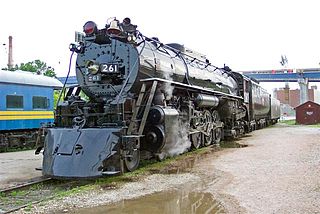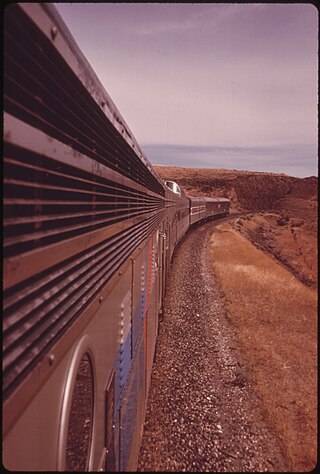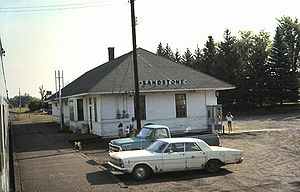
The Empire Builder is a daily long-distance passenger train operated by Amtrak between Chicago and either Seattle or Portland via two sections west of Spokane. Introduced in 1929, it was the flagship passenger train of the Great Northern Railway and was retained by Amtrak when it took over intercity rail service in 1971.

Milwaukee Road 261 is a class "S3" 4-8-4 "Northern" type steam locomotive built by the American Locomotive Company (ALCO) in Schenectady, New York in July 1944 for the Milwaukee Road.

Saint Paul Union Depot is a historic railroad station and intermodal transit hub in the Lowertown neighborhood of Saint Paul, Minnesota. It serves light rail, intercity rail, intercity bus, and local bus services.

The Hiawathas were a fleet of named passenger trains operated by the Chicago, Milwaukee, St. Paul and Pacific Railroad between Chicago and various destinations in the Midwest and Western United States. The most notable of these trains was the original Twin Cities Hiawatha, which served the Twin Cities in Minnesota. The train was named for the epic poem The Song of Hiawatha by Henry Wadsworth Longfellow.

The North Coast Limited was a named passenger train operated by the Northern Pacific Railway between Chicago and Seattle via Bismarck, North Dakota. It started on April 29, 1900, and continued as a Burlington Northern Railroad train after the merger on March 2, 1970 with Great Northern Railway and the Chicago, Burlington and Quincy Railroad. The next year, it ceased operations after the trains which left their originating stations on April 30, 1971, the day before Amtrak began service, arrived at their destinations.

The North Coast Hiawatha was a streamlined long-distance passenger train operated by Amtrak between Chicago, Illinois, and Seattle, Washington.

Midway is a former Amtrak intercity train station in the Midway neighborhood of Saint Paul, Minnesota, United States. It was last served by Amtrak's daily Empire Builder and, for a time, by the North Star, as well as briefly by the North Coast Hiawatha.

The Desert Wind was an Amtrak long-distance passenger train that ran from 1979 to 1997. It operated from Chicago to Los Angeles as a section of the California Zephyr, serving Los Angeles via Salt Lake City; Ogden, Utah; and Las Vegas.

The Olympian and its successor the Olympian Hiawatha were passenger trains operated by the Chicago, Milwaukee, St. Paul and Pacific Railroad between Chicago and the Pacific Northwest. The Olympian operated from 1911 to 1947 and was, along with its running mate the Columbian, the first all-steel train to operate in the Pacific Northwest. The streamlined Olympian Hiawatha operated from 1947 to 1961 and was one of several Milwaukee Road trains to carry the name "Hiawatha". The Olympian Hiawatha was designed by industrial designer Brooks Stevens and included the distinctive glassed-in "Skytop" observation-sleeping cars. It later featured full-length "Super Dome" cars.

La Crosse station is an Amtrak intercity train station in La Crosse, Wisconsin, served the daily Empire Builder. The station was built in 1926–27 by the Chicago, Milwaukee, St. Paul, and Pacific Railroad, replacing an older station that burned in 1916. The station was listed on the National Register of Historic Places as the Chicago, Milwaukee and St. Paul Railway Depot and was renovated in 2001.

St. Cloud station is an Amtrak intercity train station in St. Cloud, Minnesota, United States. It is served by the daily Empire Builder on its route connecting Chicago, Illinois to Seattle, Washington and Portland, Oregon. The next stop westbound is Staples while the next stop eastbound is Saint Paul Union Depot.

The Minneapolis Great Northern Depot, also known as Great Northern Station, was a passenger railroad station which served Minneapolis, Minnesota, USA. It was built in 1913 and demolished in 1978. It was located on Hennepin Avenue next to the Hennepin Avenue Bridge and across the street from the main Minneapolis Post Office.

The St. Louis County Depot is a historic railroad station in Duluth, Minnesota, United States. It was built as a union station in 1892, serving seven railroads at its peak. Rail service ceased in 1969 and the building was threatened with demolition until it reopened in 1973 as St. Louis County Heritage & Arts Center . Train service also resumed from 1974 to 1985, by Amtrak.
The Gopher and Badger were trains operated by the Great Northern Railway and then Burlington Northern Railroad until the start of Amtrak between Saint Paul, Minnesota and the Twin Ports of Superior, Wisconsin and Duluth, Minnesota via Cambridge and Sandstone.

The Twin Cities Hiawatha, often just Hiawatha, was a named passenger train operated by the Chicago, Milwaukee, St. Paul and Pacific Railroad, and traveled from Chicago to the Twin Cities. The original train takes its name from the epic poem The Song of Hiawatha by Henry Wadsworth Longfellow. There are a number of Hiawatha-themed names within the city of Minneapolis, the terminus of the original train. The first Hiawatha ran in 1935; in 1939 the Milwaukee Road introduced a second daily trip between Chicago and Minneapolis. The two trains were known as the Morning Hiawatha and Afternoon Hiawatha, or sometimes the AM Twin Cities Hiawatha and PM Twin Cities Hiawatha. The Milwaukee Road discontinued the Afternoon Hiawatha in 1970 while the Morning Hiawatha continued running until the formation of Amtrak in 1971.

The North Star was a passenger train operated by Amtrak between Duluth, Minnesota and Saint Paul, Minnesota. It originally operated from Chicago, Illinois via St. Paul to Superior, Wisconsin and Duluth, but was soon cut back to a Saint Paul–Duluth train. The service relied in part on funding from the state of Minnesota.

The Expo '74 was a passenger train operated by Amtrak between Spokane and Seattle, Washington. It operated in the summer months of 1974 in coordination with its namesake, Expo '74. With the addition of the Expo '74 to the Empire Builder and North Coast Hiawatha, Amtrak provided thrice-daily service between Seattle and Spokane, the highest level seen since Amtrak's formation and unmatched since.

The Sandstone station of Sandstone, Minnesota was built in 1895 and served the Great Northern Railway and successor Burlington Northern until 1971. Passenger service ceased upon the formation of Amtrak, but resumed between Minneapolis and Superior in 1975. Sandstone was served by the Arrowhead and later the North Star between Chicago and Duluth. Service ceased after April 7, 1985. The depot still exists, but has been relocated from the tracks.

The Cambridge station of Cambridge, Minnesota was built in 1899 and served the Great Northern Railway and successor Burlington Northern until 1971. Passenger service ceased upon the formation of Amtrak, but resumed between Minneapolis and Superior in 1975. Cambridge was served by the Arrowhead and later the North Star between Chicago and Duluth. Service ceased after April 7, 1985. The station building still exists, but has been relocated from the tracks.

The Superior Union Depot or Superior station of Superior, Wisconsin was built in 1905, replacing a previous depot, which had burned down in 1904. It was built of Lake Superior brown sandstone and designed by Duluth architects German and Lignell. The depot primarily served the Great Northern Railway, Northern Pacific Railway and Duluth, South Shore and Atlantic Railway.



















